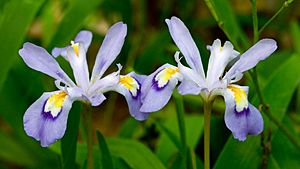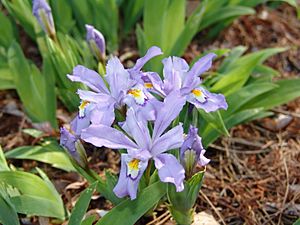Iris cristata facts for kids
Quick facts for kids Dwarf crested iris |
|
|---|---|
 |
|
| Ozark National Forest, Pope County, Arkansas | |
| Conservation status | |
| Scientific classification | |
| Genus: |
Iris
|
| Species: |
cristata
|
| Synonyms | |
|
|
The Dwarf Crested Iris (scientific name: Iris cristata) is a beautiful wild flower. It is also known as the crested iris. This plant belongs to the Iris family. It is a type of plant that grows from underground stems called rhizomes. These plants live for many years, so they are called perennials.
You can find the Dwarf Crested Iris naturally only in the eastern parts of the United States. Its flowers are usually pale lavender. They have a white patch with bright orange or yellow lines in the middle. This iris is a close relative of the Dwarf Lake Iris (Iris lacustris). The Dwarf Lake Iris is the only other crested iris found in North America. People often grow the Dwarf Crested Iris in their gardens in temperate areas because it is so pretty.
Contents
Discovering the Dwarf Crested Iris
The scientific name for this plant is pronounced EYE-ris kris-TAH-tah. The word cristata comes from a Latin word meaning "crested." This refers to the golden yellow crests on the flower's lower petals.
In the 1750s, an American botanist named John Bartram sent some of these iris plants to England. He sent them to his friend, Mr. Peter Collinson. This means the Dwarf Crested Iris has been known in Europe since 1766.
The plant was first officially described in a book called Hortus Kewensis in 1789. This book was written by William Aiton. Later, it was featured in other famous plant books and journals. The RHS (a big gardening group) officially recognizes Iris cristata as its correct name.
Plant Features and Appearance
The Dwarf Crested Iris has thin, greenish or yellowish-white rhizomes. These are like underground stems that help the plant spread. They grow close to the surface of the soil. These rhizomes can send out long branches, helping the plant form large groups over time.
The plant has 6 to 8 leaves that grow from its base. Some leaves are sickle-shaped and light brown. Others are sword-like and green or yellowish-green. These leaves are usually 7.5 to 15 cm long. After the plant flowers, the leaves grow much longer, up to 40 cm. These longer leaves help hide the seed pods that form later.
The Dwarf Crested Iris has very short stems, almost no stem at all. The entire plant, including the flower, usually reaches about 7 to 10 cm tall.
Each plant usually has 1 or 2 flowers. These flowers bloom in Spring or early Summer, usually from April to May. They only stay open for a short time. The flowers are about 3 to 5 cm wide. They come in shades of blue, like lavender, lilac, or pale blue. Sometimes you can find white flowers, and very rarely, pink ones.
Each flower has two types of petals. There are three large outer petals called 'falls'. These are about 3 to 6 cm long. They have a white patch in the center, surrounded by a dark blue or purple ring. They also have three parallel orange or yellow crests (ridges). The three inner petals are smaller and stand upright.
After the flower fades, the plant produces a seed capsule. This capsule is about 1 to 2 cm long. Inside, there are yellowish-brown seeds.
Plant Genetics and Chromosomes
Scientists have studied the genes of Iris cristata. They found that this widespread plant has a lot of genetic variety. This is different from its close relative, Iris lacustris, which has less genetic variety.
Most iris plants have two sets of chromosomes. This helps scientists identify different types of irises. The Dwarf Crested Iris usually has 32 chromosomes.
Where the Plant Grows
The Dwarf Crested Iris is native to the temperate parts of the United States.
Natural Range
You can find this iris in many states across the eastern, north-central, and southeastern U.S. This includes states like Indiana, Ohio, Illinois, Missouri, Alabama, Georgia, and North Carolina. It also grows in mountain ranges like the Ouachita, Allegheny, Appalachian, and Ozark Mountains. Its natural range is south of where the last big ice age ended about 11,000 years ago.
Preferred Habitat
This plant likes to grow in soils that contain calcium. You can find it in oak forests, on rocky hillsides, in ravines, and along streams. It also grows on mountain ledges and bluffs.
Protecting the Dwarf Crested Iris
In some states, like Maryland and Pennsylvania, the Dwarf Crested Iris is listed as 'endangered'. This means it is at risk of disappearing from those areas.
Growing the Dwarf Crested Iris
The Dwarf Crested Iris is a tough plant. It can survive cold temperatures down to about -20°C. It prefers soil that drains well and is neutral or slightly acidic. It also likes soil that is rich in humus (decayed plant matter).
This plant can grow in shade or full sun. However, it prefers cool, partly shaded spots. It needs an average amount of water, especially when it is growing. In winter, the plant goes dormant, meaning it rests.
You can plant Dwarf Crested Irises in flower borders or rock gardens. They also look great in woodland gardens, where they can spread and cover the ground. They can even grow on peat banks with other plants that like acidic soil, like camellias and azaleas.
When planting, it's a good idea to add peat or leaf-mould to the soil. The underground stems (rhizomes) should be planted about 3 to 5 cm below the soil surface. After planting, you can add a layer of leaf mulch around them. This helps keep the soil moist.
Snails and slugs can sometimes damage these plants. Deer might also nibble on them, but the plants usually survive. Other minor threats include certain insects and plant diseases. If grown in good conditions, these plants can live for up to 10 years.
How the Plant Reproduces
You can grow new Dwarf Crested Iris plants by dividing the existing plants or by planting seeds.
Dividing the plant is easier and more reliable. You should divide the plants every 3 to 4 years to keep them healthy. The best time to do this is in early fall, when the leaves turn yellow. You simply split the rhizomes into smaller clumps. Keep the new plants moist until they are established.
If you want to grow them from seeds, collect the seeds from the brown capsules after the plant flowers. Plant them in acidic or slightly acidic soil. It can take up to 3 years for a seedling to grow into a mature plant and flower.
Different Types and Cultivars

There are many different types, or 'cultivars', of Iris cristata. These are varieties that people have grown for specific features. Some popular ones include:
- 'Alba' (which has white flowers)
- 'Baby Blue'
- 'Celestial Gem'
- 'Eco Little Bluebird'
- 'Gold Crest'
- 'Pink' (a rare pink form)
- 'Shenandoah Sky' (with pale blue flowers)
- 'Tennessee White' (another white form)
Plant Safety
Like many other iris plants, most parts of the Dwarf Crested Iris are poisonous if eaten. This includes the rhizomes and leaves. If someone accidentally eats them, it can cause stomach pains and vomiting. Also, touching the plant might cause a skin irritation or an allergic reaction for some people. It's always best to be careful when handling plants you don't know.
Traditional Uses
The Dwarf Crested Iris has been used as a medicinal plant. The Cherokee Native American people used it in their traditional herbal medicines. They would make a paste from the root to help with ulcers. They also made a tea from the root for liver problems. The root was sometimes used as a spice.
In the 1800s, hunters in Virginia would chew the root to help with thirst. It tastes sweet at first, but then becomes quite strong and sharp.
Images for kids
See also
 In Spanish: Iris cristata para niños
In Spanish: Iris cristata para niños




